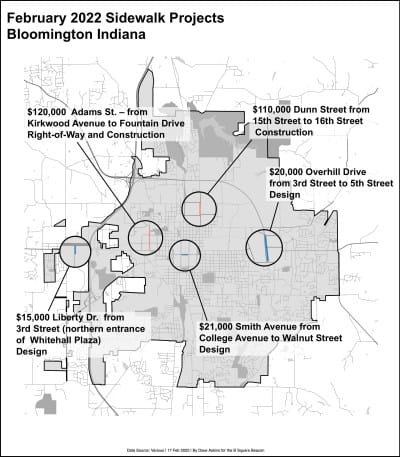City council says millions more dollars needed, but Bloomington adds a couple more sidewalk segments

Accepted on Wednesday night as a part of the Bloomington city council’s transportation committee report on sidewalks were five projects to construct or design short new stretches of sidewalk in different parts of the city.
For sidewalks this year, the city council approved $336,000 from the city’s alternative transportation fund (ATF), which was established in 1992 as part of the same ordinance that created the residential neighborhood parking permit program.
According to the residential neighborhood parking permit ordinance, “funds received in excess of the annual cost of operating the program shall go into an Alternative Transportation Fund.”
Expenditures from the fund are supposed to be for the purpose of “reducing our community’s dependence upon the automobile.”
To be built this coming construction season is a sidewalk on Adams Street from Kirkwood Avenue to Fountain Drive using $120,000 from the city’s alternative transportation fund (ATF) and $140,000 from other sources. Also to be constructed is a sidewalk on Dunn Street from 15th Street to 16th Street using $110,000 from the ATF.
A total of $56,000 from the ATF will be put towards design of three projects: Overhill Drive from 3rd Street to 5th Street; Liberty Drive south of 3rd Street at the northern entrance of Whitehall Plaza; and Smith Avenue, from College Avenue to Walnut Street.
Also a part of the transportation committee’s report approved by the council on Wednesday, was $50,000 of ATF money for resident-led projects in the general traffic calming and greenways program.
The report from the transportation committee was delivered Wednesday by committee chair Ron Smith.
During public comment on the report, Bloomington resident Greg Alexander was supportive, but pointed out that spending a few hundred thousand dollars a year would not come close to paying for all the additional sidewalks that are needed in the city.
Alexander called this year’s new sidewalks “a valuable part of the city’s transportation network.” But he added, “I feel like I have to point out yet again, this is a $50-million problem that we’re chipping off $300,000 at a time.”
A rough B Square estimate from a couple of years ago pegged the cost of building the current list of projects requested by residents at around $17 million.
But Alexander said on Wednesday, “There are a lot more worthy sidewalks that are explicitly excluded from this process, simply because they’re too big. They’re too expensive to build.”
Councilmembers agreed with Alexander that not enough money is currently available to address the need for additional sidewalks.
Councilmember Dave Rollo said, “The comments by Mr. Alexander, I think, are really spot on. There are so many sidewalks that are needed.” Rollo continued, saying that the ATF money is “not adequate to address the need.” He added, Some of those projects will have to find funding elsewhere.”
Councilmember Matt Flaherty said, “We really should be spending millions of dollars a year on sidewalks, not $600,000 or $700,000.”
On Wednesday, councilmembers did not discuss specific sidewalk funding alternatives except to mention in general terms the issuance of bonds.
The report this year came from the transportation committee, a standing committee that was briefly assigned the task of making recommendations on sidewalk funding to the full council. The transportation committee’s work this past year on sidewalk funding recommendations, for approval by the full council, came after the sidewalk committee was dissolved.
Responsibility for sidewalk funding recommendations has now been re-assigned to the newly re-established sidewalk committee.
Chair of both committees has been Ron Smith.
The way the council exercises its authority under the ordinance that established the ATF, to approve expenditures from the fund, has been the subject of controversy for more than a year. Bloomington resident Mark Stosberg analyzed the history of sidewalk funding and concluded that the allocation of funding had been subjected to political influence by the makeup of the sidewalk committee.
Stosberg concluded that a disproportionate number of sidewalk projects had been built in the council district of Dave Rollo, who has been a longtime member of the sidewalk committee.
Consistent with some recommendations in Stosberg’s report, city planning staff incorporated criteria, based on considerations of equity and location of gaps, to analyze the whole city, in an effort to identify suitable sidewalk projects. A project could be identified having a high priority, even if no one had requested it.
Previously, the process was confined to ranking a set of resident-requested projects based on the adopted criteria.
At the city council’s Feb. 4 work session, councilmember Isabel Piedmont-Smith floated the idea of a resolution that would have removed any council committee from the process for making recommendations on the sidewalk projects. Under Piedmont-Smith’s resolution, which had been co-sponsored by Kate Rosenbarger, the council would approve criteria, but would leave to the planning and engineering staff the work of sifting through projects and evaluating them.
On Feb. 4, the resolution got a cool reception from councilmembers Sue Sgambelluri, Jim Sims, Ron Smith and Susan Sandberg, who were the four members of the council who attended the work session besides Piedmont-Smith. The resolution did not appear on the Feb. 16 meeting agenda.
Responding to an emailed question from The B Square, Piedmont-Smith indicated that it was in part due to the reaction at the work session that led the resolution to be pulled from consideration by the full council.
Based on the way recent votes on the topic of committees have divided the council, the resolution to eliminate council committees from the sidewalk funding recommendation process would have likely split the group 5–4 along lines that have become familiar. The five: Sims, Sgambelluri, Rollo, Smith, and Sandberg. The four: Piedmont-Smith; Rosenbarger, Flaherty, and Volan.




Comments ()